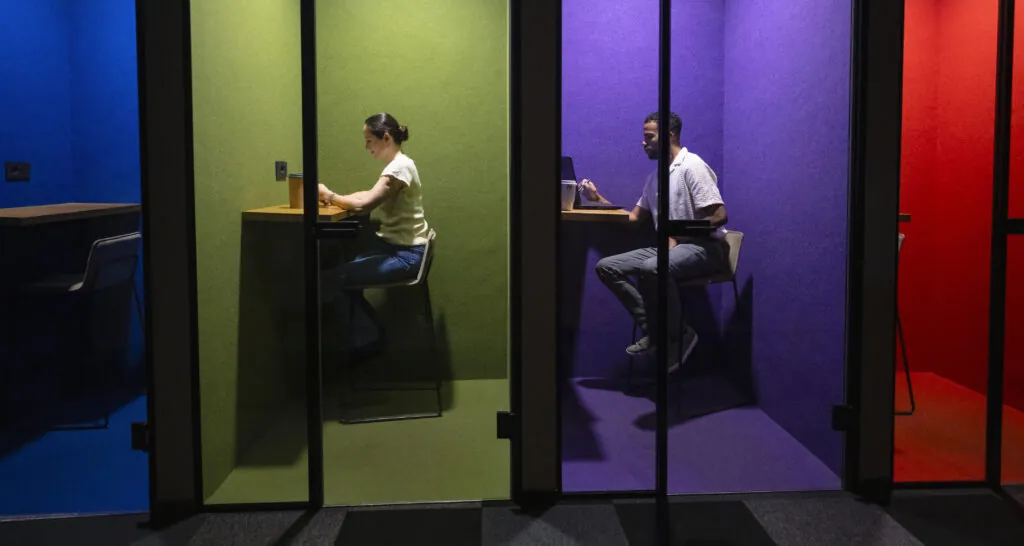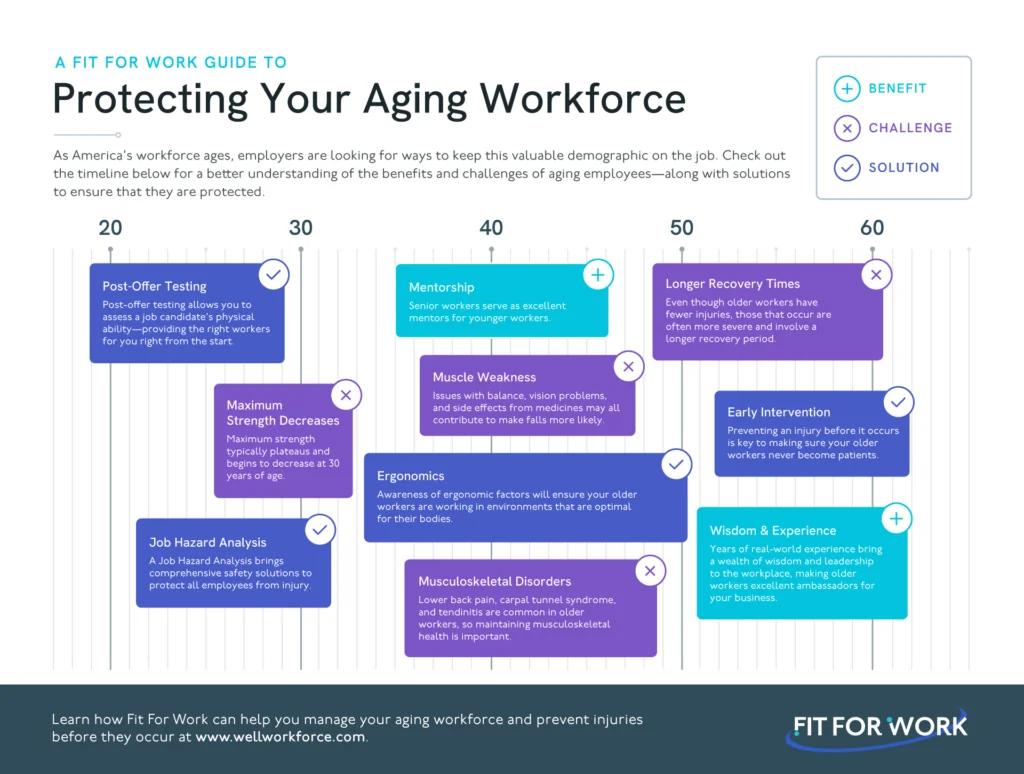By Shamyra Johnson, MHFA
Testing Technician, Fit For Work
A Wake-Up Call for Mental Health Preparedness
It was an experience I’ll never forget: during training at a client site, one of their new employees experienced a sudden and severe mental health crisis. He seemed fine earlier in the week, but by Friday, he became withdrawn, began acting unpredictably and unsafely, wandered off while speaking unintelligibly, showed signs of self-harm, and eventually collapsed, unresponsive, on the lunchroom floor.
Everyone onsite acted quickly to get him the help he needed in that moment while keeping employees safe, but the event left us shaken. The truth was, we didn’t feel fully prepared for a mental health crisis of this magnitude.
Why Our Team Needed to Reassess Our Approach
While we had thorough safety protocols in place for physical emergencies—such as machinery accidents, fires, or injuries—we recognized an opportunity to grow in how we support mental health. We were motivated to make changes that would enable us to respond with care and compassion. We understood that any action we took would ripple throughout our team, fostering a more supportive and well-rounded approach to safety and well-being. Because no matter how compassionate or diligent an organization is in screening new hires, it’s impossible to predict when someone may experience a mental health crisis.
Mental health issues require the same proactive awareness, training, and safety protocols as injury prevention programs.
Turning a Difficult Moment Into Meaningful Change
Following the incident, our team reflected on our approach to mental health and opportunities for improvement. The result? A desire to enhance our internal practices but also sharpen the tools we can offer our clients to help them better support their teams.
As an organization, we now pursue Mental Health First Aid (MHFA) Training to equip ourselves with the skills to recognize the signs of mental distress and intervene appropriately. This is a valuable resource we can recommend to our clients as part of building a foundation for better mental health awareness in the workplace.
Additionally, we are committed to fostering a supportive culture where mental health is discussed more openly and without stigma. We are continually striving to nurture ongoing dialogue about mental health within our organization, and this is something we also promote to our clients as part of creating a more inclusive, compassionate work environment.
This initiative is about more than just preparing for emergencies. It’s about ensuring that every individual—whether part of our team or a client’s—is seen, supported, and safe. It’s about understanding and addressing stress factors before they escalate. Our goal is to help our clients build workspaces that prioritize mental well-being and promote a healthy, supportive environment for everyone.
The Importance of Mental Health Literacy
In previous blogs, we’ve highlighted stress in the workplace and strategies for maintaining mental well-being in high-pressure industrial environments. In this follow-up, we’ll dive deeper into mental health literacy, providing the tools and knowledge to better recognize and prevent potential crises in the workplace.
Mental health literacy is essential for any workplace, particularly those that prioritize employee well-being, and refers to the knowledge and understanding of mental health disorders. This encompasses how to act to prevent a crisis, offer support, and promote wellness. It’s a proactive, educational approach that equips everyone in the workplace to respond confidently.
We can all think back to poor workplace experiences, then contrast those with positive environments where managers fostered a healthy and productive workplace. According to the American Psychological Association (APA) 2023 Work in America™ Survey, nearly one-quarter (22%) of workers reported concern about mental health harm from their work, with 19% describing their environment as downright “toxic.” Note that most workers (92%) said it is very (52%) or somewhat (40%) important to them to work for an organization providing mental health support.
Today’s managers must understand and demonstrate that mental health is a holistic part of workplace health, where we acknowledge, respect, and care for the whole person. This strategy is also part of a corporate commitment to safety, wellness, and health, as organizations seek to maintain a healthy workforce while avoiding OSHA recordable/reportable incidents and workers’ compensation claims.
What Mental Health Literacy Looks Like:
- Recognize signs of mental illness – notice changes in employee behavior (e.g., social withdrawal), performance, attendance, or irritability
- Understand risk factors – including high job demands, excessive workloads, low job control, lack of team/manager support, and a changing culture or new technology
- Know how to seek help – leverage resources inside/outside the organization to safeguard employees; comply with injury prevention protocol, OSHA regulations, and workers’ compensation guidelines
- Promote positive mental health – reduce the stigma and encourage open, confidential dialogues as part of your health and wellness initiative
- Support people who are struggling – simply asking, “How are you doing?” and really listen to the answer, then offer positive encouragement
Mental health literacy is about developing communication, compassion, and confidence around mental health issues – personally and professionally.
Barriers to Literacy and Care
Availability of mental health resources isn’t equal for everyone. Many people lack access to mental health care as part of basic healthcare services. Several factors can influence this, including:
- Access to care – Over 75 million American adults do not have a primary care doctor, which impacts their ability to access care, including mental health services.
- Education levels – Adults with lower levels of education are more likely to experience health literacy challenges. About half (49%) of adults with less than a high school education have “below basic” health literacy; in contrast, only 15% of high school graduates and 3% of bachelor’s degree holders face this challenge.
- Age and race – Older adults and individuals from certain racial or ethnic groups face disparities in health literacy, making it harder for them to navigate mental health resources. Adults ages 65+ have the lowest health literacy of any adults, with 29% having “below basic” health literacy.
How You Can Support Mental Health in the Workplace
It’s not just about responding in a crisis; it’s about creating an environment where mental health is a priority every day. Practical strategies for organizations include:
- Pursue education/training – certification in mental health first aid can help develop a common language and establish a protocol for crisis prevention
- Normalize mental health – acknowledge its role in workforce health and discuss ways to improve well-being
- Provide resources – offer access to internal/external mental health support; have team members certified in mental health first aid, an 800 phone/text crisis number, plus an insurance contact for approved therapists
- Develop policies – drive inclusion of mental health training and protocols; foster awareness, communication, plus appropriate actions
- Promote work-life balance – including personal days, opportunities for education/activities outside of regular duties, and encourage whole-person health and wellness
Conclusion
When organizations make mental health a priority, it really can make a difference in a person’s mental well-being and ability to function – on the job and when they go home to their families. Developing literacy as part of your corporate culture, along with a mental health strategy, leads to decreased absenteeism, improved productivity, and higher employee satisfaction.
An investment in mental health literacy will increase understanding of these issues and establish a common language for your team. You’ll also be better prepared to recognize and prevent a mental health crisis. It’s a compassionate approach as well as a strategic imperative for safety, wellness, and health in the workplace.
Resources to Help
- Training – Mental Health First Aid (MHFA) certification helps team members identify, understand, and respond to signs of mental health challenges. There are many free, online MHFA courses, highly recommended by our Fit For Work team.
- The 988 Suicide & Crisis Lifeline – Provides mental health support from trained crisis counselors 24/7, nationwide. The 988 fact sheet can be posted in breakrooms.
- National Alliance on Mental Health (NAMI) – This organization offers additional information on preparing for a mental health crisis, along with state and community resources.
- My Mental Health: Do I Need Help? – This poster can be a resource for employees in the workplace who may need to “check in” on mental well-being.

Shamyra Johnson is a native of New Orleans, Louisiana, and a graduate of Southern University A&M College, where she earned a Bachelor of Science degree with a concentration in therapeutic recreation. Before joining Fit For Work in October 2021, she gained diverse experience working as a physical medicine and rehabilitation tech in an inpatient acute care hospital, in post-acute rehab, and at an Applied Behavior Analysis clinic supporting children on the autism spectrum.
At Fit For Work, Shamyra provides post-offer employment testing services. She also contributes to the FFW Institute as a course builder and is a recently certified Mental Health First Aider. Outside of work, she enjoys attending festivals, cooking, spending time with family and friends, and embracing new experiences.





